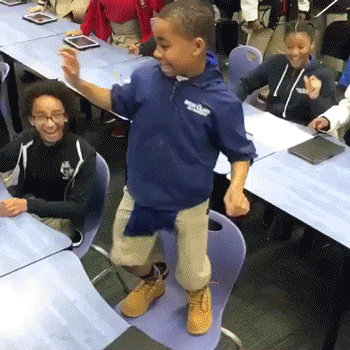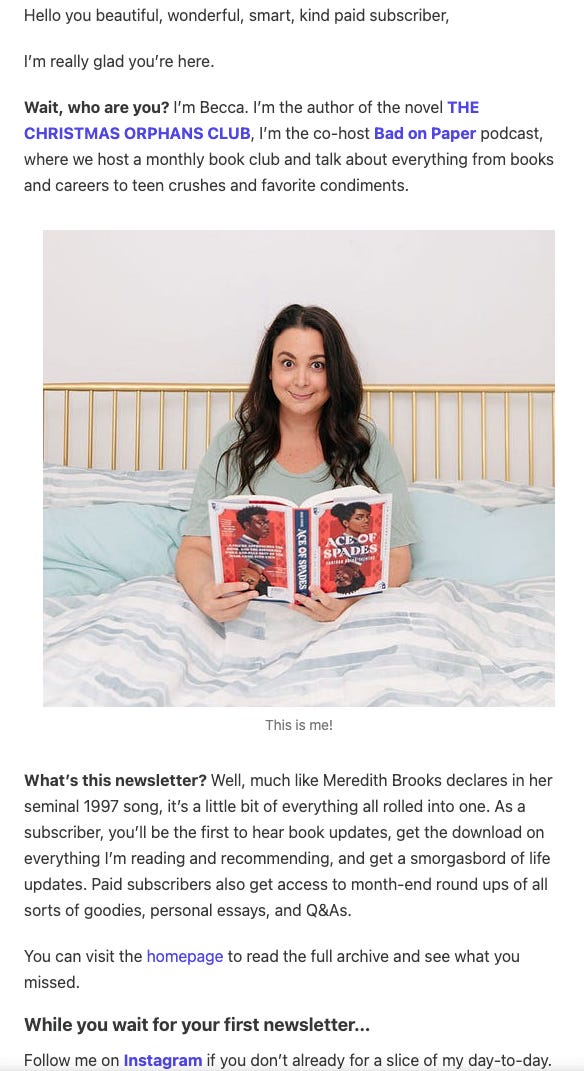Your welcome email is your readers' first impression. Here's how to make it count.
You subscribed. I'm flattered. Let's not make it weird.
Ever subscribed to a newsletter and then stared at the welcome email thinking, "Wait, who is this person and what is this about?"
Yeah, me too.
Substack only sends a few automated emails, and this is one of them.
It's the first impression a new reader gets of you, and it counts.
We're so scattered online because so many things are competing for our attention that they may have forgotten why they hit the subscribe button when it lands in their inbox. This is a critical reader touchpoint where you can build trust with a bit of personality.
I know, I know.
You became a writer to share your expertise or tell your story, not to fuss over automated emails.
But in today's newsletter landscape, this is one of those small details that punches way above its weight.
Here's the thing: your welcome email isn't just administrative housekeeping. It's the first real conversation between you and your reader. It sets the tone, builds connection, and helps them decide if they'll keep opening your emails.
It’s a real opportunity to surprise and delight your reader.
After looking at dozens of welcome emails and helping clients craft their own, I've found that the best ones don't need to be flashy or over-engineered. They just need to feel human, clear, and a little unexpected.
I pulled together six elements that I found in strong welcome emails.
Think of what’s below as things you can mix and match, rather than using all six elements at once.
Having all of them could overwhelm busy readers who skim. You want to hook readers' attention and let them know what to expect from you.
Switch these around every so often to keep your welcome email fresh.
So let’s get started….
Six Elements of a Great Welcome Email
Think of this as an opportunity to create something that feels authentically you.
1. Warm Personal Introduction
The best emails feel like they come from a friend, not a brand or a marketing department. (Or god forbid, ChatGPT:) It’s a chance to introduce yourself and your newsletter in a natural and inviting way.
📌 Becca Freeman keeps it simple:
"Wait, who are you? I'm Becca. I'm the author of the novel, The Christmas Orphans Club and am currently working on a second yet-to-be-announced novel that currently lives in a word doc on my computer. I’m also a co-host of the Bad on Paper podcast with Oliva Muenter."
📌 Paul Bogaards takes a different approach:
"Well, there's no going back now. I'm here. In your fucking inbox. Sharing. Jeezus. Wish me luck. And while we’re at it, wish yourself luck as well. The way I see it we’re all gonna need it."
It's dry and self-aware, and it immediately tells you what kind of voice to expect. You can’t help but smile when you read this.
2. Clear Expectations
People don't like guessing games. Tell them what they'll get and how often they'll hear from you. This doesn't mean you need to email on a rigid schedule—just be clear about whether you're a "once a week" or an "occasional thoughts when inspiration strikes" kind of writer.
📌 Be straightforward about your content:
"Expect a mix of essays about parenthood, book recommendations, and the occasional recipe that's saving my weeknight dinner situation."
No fluff, no gimmicks—just a clear promise about what's to expect.
3. Surprise & Delight Elements
This is where you can let your personality shine through. The best welcome emails have something unexpected—humor, a pop culture reference, or a small thoughtful touch that makes it feel more personal.
📌 Becca Freeman uses humor:
She does this immediately with a photo, and then towards the bottom (which is cut off here) she points to her most read posts by saying: "Alright, Veruca Salt, I get it—you want the content NOW!"
📌 Deborah Copaken of Ladyparts includes a baby photo of herself with the caption: "It's how I feel setting up this new way of communicating."
Fun photos, gifs, and small details don't take much effort, and they immediately build a rapport with your reader.
4. Start Here Section
Don't assume new readers will go digging through your archives. Instead, give them a few curated links to your best or most relevant work.
I suggest sharing 1-3 posts maximum—anything more starts to feel like homework.
Think of it as: "If you're new here and want to get a sense of what I'm about, start with these." And make sure they’re free and not behind a paywall.
📌 Example of a simple approach:
“I’ve removed the paywall from these reader favorites to give you a taste the best stuff.”
"If you're new here, you might enjoy these reader favorites:
[Title of popular post]
[Title of something that’s a community building piece]"
5. Invite Engagement
A welcome email doesn't have to be one-sided. Asking a simple question can turn passive subscribers into engaged readers.
📌 Some questions that work well:
"Where are you reading from?"
"Hit reply and tell me what's happening in your life that made you sign up today."
"What's your biggest challenge with [topic of your newsletter]?"
Getting people to hit reply serves double duty—it starts building a relationship AND helps keep your future emails out of spam folders.
6. Housekeeping & Tech Tips
Help your readers stay connected by making sure your emails don’t go to spam.
📌 Give them a reminder:
If you can’t find the newsletter, check your spam & promotions folder.
And please mark this address as ‘not spam.’
A quick reply to this email guarantees the next one won’t go to spam!
📌 Consider explaining the app: Here’s how I'm experimenting with adding a brief explanation about the Substack app:
"You'll receive updates in your inbox, or you can download the Substack app and read posts there. If you want to like or comment on these emails, all that happens in the app. If you’re reading this strictly in your inbox, just hit reply, and I’ll get right back to you. Love hearing from you either way."
If people are reading just in the inbox, giving them some context about the app is helpful. Especially if you have email readers who get caught off guard trying to like or comment on an email and get pulled into setting up a Substack account they may not want.
Your welcome email is a critical first conversation. In a world of endless distractions, it's your chance to remind someone why they subscribed in the first place and guide them toward the content that you want them to start reading.
Should You Ask Them to Upgrade to Paid?
This is one of the most common questions I hear, and my answer might surprise you: probably not in your welcome email.
They’ll be seeing that “upgrade to paid” button in every newsletter after this. So, adding it right away can feel like too much, too soon.
If you do want to mention paid subscriptions, consider a gentle nudge in the P.S. rather than making it the main focus:
"P.S. As a free subscriber, you'll get [benefits]. If you'd like [additional benefits], you can upgrade to a paid subscription anytime."
Research shows it typically takes 3-6 months for someone to buy from you after joining your email list. With Substack, we can translate that to "upgrade to paid” subscribers.
Building trust comes first.
Common Mistakes to Avoid
➡️ Overwhelming new readers with too many links. Less is more here—save your extensive archive for later.
➡️ Leaving the Substack default copy and only adding a few sentences. Just don’t. 🥴
➡️ Forgetting to include a specific invitation to engage. A simple question can dramatically increase your connection with readers.
➡️ Using the default subject line. "You're on the list" doesn't exactly scream "open me!" Think about something with a bit more personality.
Remember…
Your welcome email is that critical first conversation. In a world of endless distractions, it's your chance to remind someone why they subscribed in the first place and guide them toward the content that you want them to start reading.
Readers find you through different paths and touchpoints. Whether they came from social media, a friend's recommendation, or somewhere else entirely, your welcome email is one of your few guaranteed opportunities to make a consistent impression and build trust.
If you're working on your own welcome email, ask yourself: Does this sound like me? Would I want to read it? If not, it might be time for a refresh.
What's one small thing you could add to your welcome email to make it feel more like you?
Hit reply—I'd love to know.
✨ A few other articles to inspire & understand reader relationships:

















I subscribe to someone who reviews TV shows and movies. I'd been commenting so much on her posts that I guess she decided to check me out and decided to subscribe. And then ended up posting a Note that it was the best welcome email ever. LOL *buffs nails on my shoulder*. Guess I nailed it. LOL
Jen, this is brilliant advice! If I was a copy coach instead of a VA, this would be my #1 tip for Substackers.
I saw you quietly nodding your head in my workshop the minute I told everyone to STOP IGNORING your welcome emails 🤣